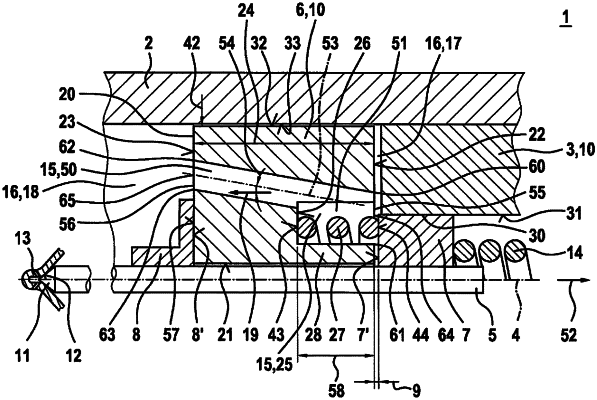| CPC F02M 51/0685 (2013.01) [B05B 1/3053 (2013.01); F02M 61/10 (2013.01)] | 22 Claims |

|
1. A valve for metering a fluid, comprising:
a valve housing, in which an internal pole is stationary-mounted;
an electromagnetic actuator which includes an armature situated in an armature space and positioned on a valve needle, wherein the valve needle is operable by the actuator using the armature, the armature being guided on the valve needle, wherein the valve needle is situated inside of the valve housing and is guided along a longitudinal axis of the valve needle and/or the armature, relative to the valve housing;
a first stop element that interacts with a first end face of a first stop element of the armature during operation, and a second stop element that interacts with a second end face of a second stop element of the armature during operation, situated on the valve needle, the first stop element and the second stop element limiting a movement of the armature relative to the valve needle, the armature having a spring receptacle which is open towards the first end face of the armature, and into which a spring supported at the first stop element is inserted, wherein the first stop element and the second stop element are positioned on the valve needle;
a valve-closure member, which interacts with a valve-seat surface to form a sealing seat, is formed on the valve needle, wherein upon actuation of the armature, the valve-closure member is accelerated in a direction of the internal pole, and wherein when the armature strikes against the first stop element, which is a limit stop, to actuate the valve needle, the fluid is then injected through the sealing seat in an open configuration, and at least one nozzle opening, into a space;
wherein the armature has at least one fluid channel, which, during operation, allows the fluid to pass through between a first region of the armature space bordering on the first end face of the armature and a second region of the armature space bordering on the second end face of the armature, the at least one fluid channel incorporating at least a portion of the spring receptacle, and wherein the at least one fluid channel runs radially outwardly in sections, along a direction, which is oriented from the first end face towards the second end face and is coaxial relative to the longitudinal axis,
wherein the at least one fluid channel includes an oblique bore hole, wherein the at least one fluid channel leads through the oblique bore hole and at least a portion of the spring receptacle, wherein a coaxial direction with regard to the longitudinal axis results, which is oriented from the first end face to the second end face,
wherein the oblique bore hole is formed in the armature so that it runs radially outwards along the coaxial direction and away from the longitudinal axis, so that there is an angle of inclination between the coaxial direction and an axis of oblique bore hole, and
wherein the at least one fluid channel includes a first coaxial blind-end bore, which runs in the coaxial direction, starting from the first end face of the armature, and a second coaxial blind-end bore, which runs contrary to the coaxial direction, starting from the second end face of the armature.
|